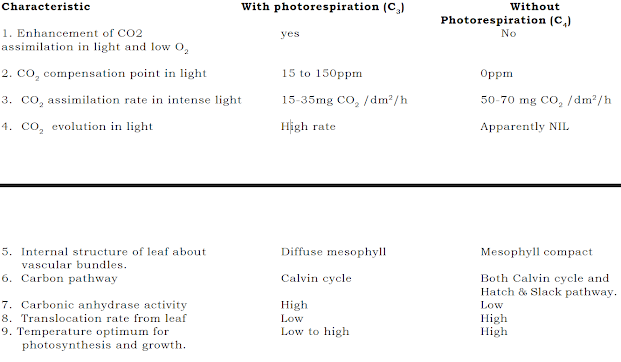Processes or Steps of Photorespiration
Like usual mitochondrial respiration, photorespiration is also an oxidative process where oxidation of glycolate occurs with subsequent release of CO2 (post-illumination burst of CO2).
The process of photorespiration takes place in three cell organelles viz., chloroplasts, peroxisomes, and mitochondria. Various steps of the glycolate metabolism synthesis of glycolate and its oxidation with subsequent release of CO2 (photorespiration).
A. Reaction in Chloroplast
1.1. Glycolate is synthesized as a side product from some intermediates of photosynthesis in chloroplasts. It is probably derived from 1-C and 2-C of the ketose sugar phosphates of the Calvin cycle.
1.2. It is believed that O2 competes with CO2 for the enzyme RuBP carboxylase. When this enzyme reacts with O2 instead of CO2, it is called RuBP oxygenase.
1.3 In the second case, one molecule of phosphoglyceric acid (PGA) and one molecule of phosphoglycolic acid are formed from RuBP.
1.4. PGA then enters into the Calvin cycle.
1.5 Phosphoglycolic acid is dephosphorylated to form glycolate, in the presence of the enzyme, phosphatase.
B. Reactions in Peroxisome
2.1 From chloroplasts, the glycolate migrates into the peroxisome where it is oxidized (photorespired) to glyoxalate in the presence of glycolic acid oxidase. In this reaction, hydrogen peroxide (H2O2)is formed with the utilization of one molecule of O2. The H2O2 is then removed by the enzyme catalase as follows:
H2O2 → H2O + 1/2O2
2.2 Glyoxalate is converted into an amino acid, glycine by transamination reaction in the presence of
L-Glutamate glyoxalate transaminase.
C. Reactions in Mitochondrion
3.1 Glycine formed in peroxisomes migrates into mitochondria
3.2 Now, two molecules of glycine react to form one molecule of another amino acid, Serine, liberating CO2 (post-illumination burst of Co2 and photorespiration) and NH3. This reaction is catalyzed by serine hydroxymethyltransferase.
Serine thus formed is apparently recycled back into the pool of photosynthetic intermediates of Calvin cycle in chloroplasts. This is mediated by the formation of hydroxypyruvate and glyceric acid.
On phosphorylation with ATP, glyceric acid is converted into PGA, which is the intermediate of the Calvin cycle. Therefore, starting from intermediates of the Calvin cycle and with the synthesis of glycolate, serine is formed which is again converted into intermediates of the Calvin cycle thus completing the glycolate cycle. The photorespiratory cycle is also called as C2 cycle.

Comments
Post a Comment